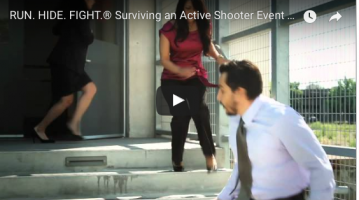COPING WITH AN ACTIVE SHOOTER SITUATION
- Be aware of your environment and any possible dangers
- Take note of the two nearest exits in any facility you visit
- If you are in an office, stay there and secure the door
- Attempt to take the active shooter down as a last resort
PROFILE OF AN ACTIVE SHOOTER
An active shooter is an individual actively engaged in killing or attempting to kill people in a confined and populated area, typically through the use of firearms.
CHARACTERISTICS OF AN ACTIVE SHOOTER SITUATION
- Victims are selected at random
- The event is unpredictable and evolves quickly
- Law enforcement is usually required to end an active shooter situatio
HOW TO RESPOND HOW TO RESPOND WHEN AN ACTIVE SHOOTER IS IN YOUR VICINITY
1. EVACUATE
- Have an escape route and plan in mind and know all exits, conventional or otherwise.
- Run and keep your head below windows, cabinets, etc
- Leave your belongings behind
- Keep your hands visible
2. HIDE OUT
- Hide in an area well out of the shooter’s view
- Know where all impenetrable solid objects like thick concrete walls, engine blocks, safes are located
- Block entry to your hiding place (e.g.a desk under the door handle) and lock the doors
- Silence your cell phone and/or pager
3. TAKE ACTION
- When your life – or the life of someone you are prepared to die for – is in imminent danger:
- Attempt to incapacitate the shooter
- Act with physical aggression and throw items at the active shooter
- Shoot. As Wayne LaPierre likes to observe, “The best thing against a bad guy with a gun is a good guy with a gun.” If you have a gun now’s the time to use it. I also carry a taser. Remember to get some defense handgun training. Having a gun is one thing. Shooting at moving living target under pressure is a whole different thing. (Message me below if you want to know where I go for this training, Kelly)
HOW TO RESPOND WHEN LAW ENFORCEMENT ARRIVES
- Remain calm and follow instructions
- Put down all items in your hands (i.e., bags, jackets)
- Raise hands and spread fingers and put your own weapon down gently
- Keep hands visible at all times
- Avoid quick movements toward officers such as holding on to them for safety
- Avoid pointing, screaming or yelling
- Do not stop to ask officers for help or direction when evacuating
INFORMATION YOU SHOULD PROVIDE TO LAW ENFORCEMENT OR 911 OPERATOR
- Location of the active shooter
- Number of shooters
- Physical description of shooters
- Number and type of weapons held by shooters
- Number of potential victims at the location

